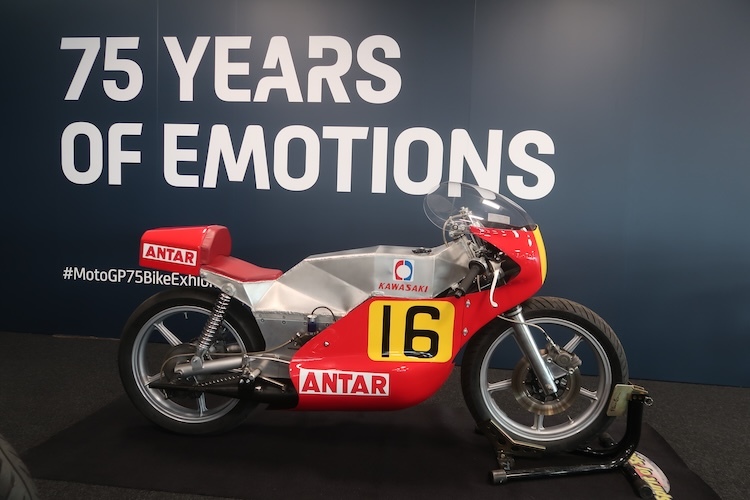While the MotoGP elite were chasing great times at Silverstone, a special exhibition of important GP bikes prepared with great enthusiasm was also causing a stir.
The final weekend of the Grand Prix at Silverstone was chosen as the “75 Years of MotoGP” celebration for good reason. In the summer of 1949, the first official rounds of the MotoGP World Championship were held on the Isle of Man. It’s hard to understand today – it wasn’t until 1976, by which time the aerodynamically efficient half-litre cars were already approaching the 300 km/h top speed, that the Isle of Man lost its status as a World Cup host.
Despite all the classic gloom at Silverstone, the focus was on the hectic day-to-day business of MotoGP, but the event still did justice to the historical theme. Not only did the MotoGP teams play a huge part in this with their distinctive and ongoing liveries and designs, but the British Grand Prix organisers also put in a lot of effort.
The special exhibition held in the impressive pit building, which featured around 30 exciting race bikes from all eras of MotoGP history, was well worth a look. The range ranged from the almost unknown 1950s 7hp Nougier four-stroke to the current 300hp Yamaha YZR-M1. What both bikes had in common was a top speed of over 16,000rpm. What was great: the exhibition was free to all event visitors; no tickets or special passes were required.
During the tour through the range, which was made possible with the help of the famous Sammy Miller Group, but also thanks to a number of private owners, teams and manufacturers, it was not just the old-timers who were being swallowed up.
It started in style with the half-litre AJS with which Les Graham won the first official 500cc and premier class world championships in 1949. In 1949 the twin produced 40bhp. But Graham was already travelling with a 190-something at the time and without a fairing.
In addition, the single- and twin-cylinder designs of the Matchless and Norton brands dominated the 1950s. The actual blueprint for the modern four-stroke racing engine was also presented at Silverstone – in the form of the Gilera 500 GP. Because Piero Remor’s design was the first to inspire MV Agusta to create its own four-cylinder engine. The half-litre Gilera won a total of seven world championship titles and in its final 70 hp expansion phase was already capable of reaching speeds of over 240 km/h.
Also at Silverstone: Mike Hailwood's 1962 Touring Car and a rare 250cc Mondial from the 1959 season. Thanks to its luxurious full bodywork, the 29bhp four-valve single-cylinder reaches 220km/h.
Two-stroke GP engines were the majority of the special exhibit. From early Dave Simmonds Kawasaki, several Yamaha TZs, the original factory MZ, the first Suzuki RG 500 and the successful Aermacchi to the odd highlight of GP history – the 350 Harley-Davidson, with Walter Villa in 1976 becoming world champion. With a shout out to heavy metal friends, Villa's two-stroke racer was a 275+ thing with a venomous 80bhp and 105(!) kilos.
In addition to a full contingent of Suzuki RG 500s, from Sheene to Uncini, the latest 500 two-stroke engines were also on display, including Kenny Roberts Jr.'s world champion Suzuki RGV and the three-cylinder KR500 that Jeremy McWilliams used to claim the last pole position in history for a two-stroke racer.
In addition to the huge buzz that Silverstone Raceway witnessed, along with the legends of the past days, fans in England and visitors from all over the world were able to enjoy an unforgettable spectacle. Because with British pragmatism, many of the racing bikes on display began to cheer.

“General writer. Twitter fanatic. Award-winning alcohol practitioner. Pop culture guru.”








More Stories
Novak and Misolek also continue.
Resignation from resignation! ÖSV runner returns to the World Cup
Rodri speaks about the professional strike